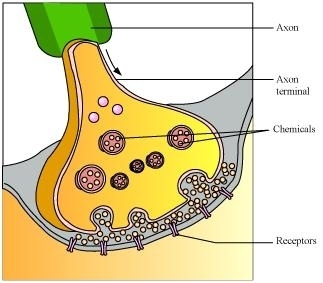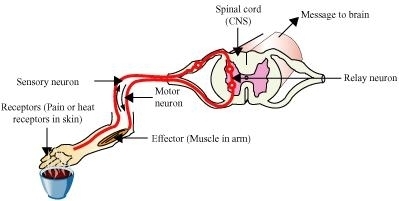NCERT Solution: Control and Coordination
A reflex action is a rapid, automatic response to a stimulus. It does not involve any thinking. For example, we close our eyes immediately when the bright light is focused. Walking, on the other hand, is a voluntary action. It is under our conscious control.
A very small gap that occurs between the last portion of axon of one neuron and the dendron of the other neuron is known as a synapse. It acts as a one way valve to transmit impulses in one direction only. This uni-direction transfer of impulses occurs as the chemicals are produced in only one side of the neuron i.e., the axon's side. From axon, the impulses travel across the synapse to the dendron of the other neuron.

Cerebellum, a part of hindbrain is responsible for maintaining posture and equilibrium of the body.
The thinking part of our brain is the forebrain. It has separate areas that are specialized for hearing, smelling, sight, taste, touch, etc. The forebrain also has regions that collect information or impulses from the various receptors. When the smell of an incense stick reaches us, our forebrain detects it. Then, the forebrain interprets it by putting it together with the information received from other receptors and also with the information already stored in the brain.
Reflex actions are sudden responses, which do not involve any thinking. For example, when we touch a hot object, we withdraw our hand immediately without thinking as thinking may take time which would be enough to get us burnt.
The sensory nerves that detect the heat are connected to the nerves that move the muscles of the hand. Such a connection of detecting the signal from the nerves (input) and responding to it quickly (output) is called a reflex arc. The reflex arcs - connections present between the input and output nerves - meet in a bundle in the spinal cord.

Reflex arc
Reflex arcs are formed in the spinal cord and the information (input) reaches the
brain. The brain is only aware of the signal and the response that has taken
place. However, the brain has no role to play in the creation of the response.
Plant hormones or phytohormones are naturally-occurring organic substances. These are synthesized in one part of the plant body (in minute quantities) and are translocated to other parts when required. The five major types of phytohormones are auxins, gibberellins, cytokinins, abscisic acid, and ethylene.
The movement of leaves of the sensitive plant, Mimosa pudica or “touch me not”, occurs in response to touch or contact stimuli. This movement is independent of growth. The movement of shoot towards light is known as phototropism. This type of movement is directional and is growth dependent.
Auxin is an example of growth-promoting plant hormone.